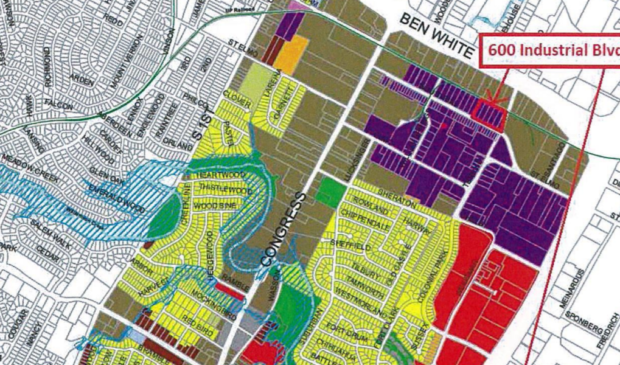Industrial lot wins mixed-use zoning on second reading
Wednesday, December 11, 2019 by
Jo Clifton Although Council Member Pio Renteria pushed for more affordable housing on a Southeast Austin site that is currently industrial, he made the motion to approve the compromise offered by attorney David Hartman at last week’s Council meeting.
Before the vote, Jerry Rusthoven of the Planning and Zoning Department reminded Council that state law prohibits it from requiring affordable housing as a condition of zoning.
The vote was 10-1, with Council Member Natasha Harper-Madison declining to join Renteria in approving the change from limited industrial to mixed use under a planned development agreement (LI-CO-NP to LI-PDA-NP).
The four-acre property is in Renteria’s District 3, just one lot south of Ben White, close to its intersection with Interstate 35. The site will also feature 20,000 square feet of retail and a brewery with a beer garden, in addition to 400 apartment units.
According to a city staff report on the property, “Over the past five years, the industrial district where this site is located has undergone and is experiencing change. During this time, there have been seven approved zoning change requests to allow mixed use and dense residential development. While these requests were mostly in alignment with the South Congress Combined Neighborhood Plan, they are probable precursors of development that will change the fundamental heavy commercial/industrial character of the area.” As part of the report, staffers recommended that the city study industrial areas around the city to ensure that some of those endure.
Attorney David Hartman, representing Keller Capital, told Council Thursday that his client had agreed to some requests from the neighborhood planning team in addition to the approximately 20 items they had previously promised. The property owners would not allow a payday lending office on the site and would notify the neighborhood whenever the property is sold, he said.
The developer has also promised to provide drainage and detention infrastructure for the property, as well as traffic improvements, sidewalks and bike lanes.
More important for Council’s purposes, however, is the fact that Keller Capital will enter into a restrictive covenant with the neighborhood and Habitat for Humanity. The agreement will mean that 10 percent of the 400 apartments will be reserved as affordable housing.
Keller Capital had previously promised that 5 percent of the units would be reserved for people making 60 percent of the median family income and 5 percent would be reserved for people with 80 percent MFI.
After discussions with Renteria’s office, Hartman said, his client would be willing to adjust the terms of the restrictive covenant so that 6 percent of the units are reserved for people with 60 percent MFI and 4 percent for those in the 80 percent MFI bracket.
Hartman pointed out that the developer had agreed to seek an 85-foot height for the property even though an adjacent property is already zoned for 125 feet. He also noted that a nearby property owner on South Congress had agreed to 10 percent affordable units but withdrew his zoning request after second reading so now there will be no affordable units on that spot.
Neighborhood leader Mario Cantu told Council his group already had nine or 10 meetings with the developer and one or two more would not hurt either side. Cantu said the neighborhood still wants to push for 10 percent at 60 percent MFI.
Renteria made the motion for approval, saying, “This is a very tough decision for me. We’re giving up a lot of entitlement here. It’s 85 feet. I know that we’re going to be losing a lot of our industrial sites in that area, and I’m willing to convert that whole area … I really feel that we need to be able to bring in affordability to that area. … The cost is just going up so high here.”
He continued, “I would like to pass this, but if I feel like we’re not able to get some of the entitlement that I feel like that area deserves, I don’t want to turn it into a high-income area where South Austin cannot afford to live there anymore.”
Map courtesy of the city of Austin.
The Austin Monitor’s work is made possible by donations from the community. Though our reporting covers donors from time to time, we are careful to keep business and editorial efforts separate while maintaining transparency. A complete list of donors is available here, and our code of ethics is explained here.
You're a community leader
And we’re honored you look to us for serious, in-depth news. You know a strong community needs local and dedicated watchdog reporting. We’re here for you and that won’t change. Now will you take the powerful next step and support our nonprofit news organization?




